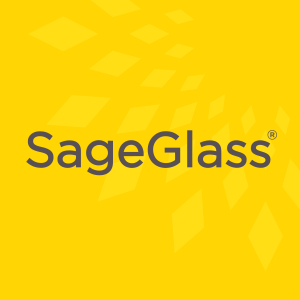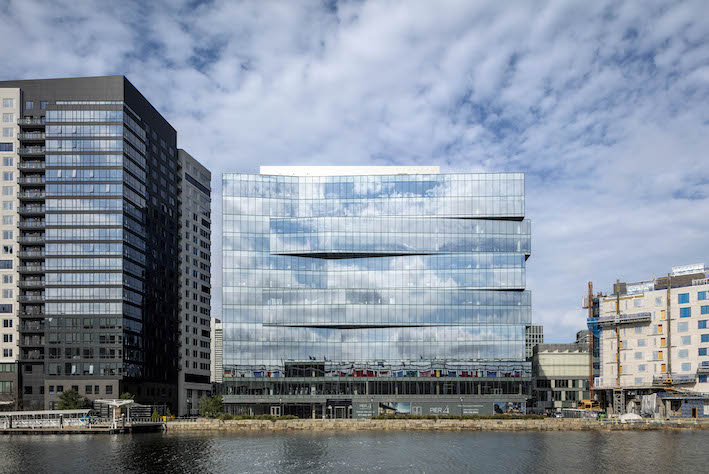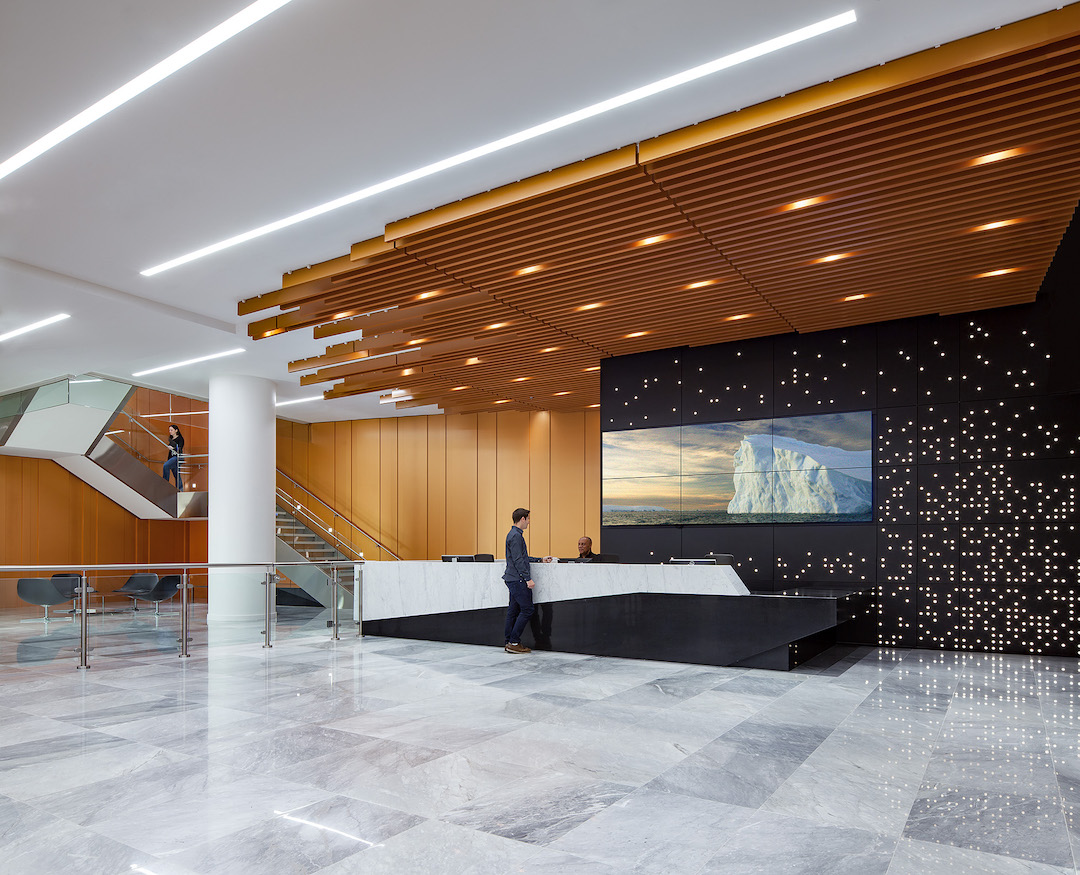Corporate space consolidation and the need to upgrade the employee experience will keep the office market fairly strong for the next 18 months before the sector taps the brakes. “I don’t think it will be anything dramatic, but I think there will be a leveling,” says Dennis Cornick, EVP, Gilbane Building Company. Construction costs and a slackening demand for space built on spec will dampen the market, he says.
In the last year, open office design has come under attack by Harvard Business School. Recent HBS studies found that when employees moved from a traditional office setting to an open office, collaboration actually declined. Many workers plugged wireless devices in their ears to tune out office noise—and their co-workers. The studies have prompted designers and real estate decision makers to rethink the open-office trend.
 The 2019 Office Giants Report is sponsored by SageGlass. Also check out these 2019 Office Sector rankings, brought to you by SageGlass:
The 2019 Office Giants Report is sponsored by SageGlass. Also check out these 2019 Office Sector rankings, brought to you by SageGlass:
• Top 200 Office Sector Architecture Firms
• Top 100 Office Sector Engineering Firms
• Top 110 Office Sector Construction Firms
“I’ve heard different opinions from different clients,” says Cornick. Some open office projects have been successful, he says; others have not fostered the expected level of collaboration. Nonetheless, he says, “The drive for more collaboration and teamwork is almost a universal desire.”
With no universally accepted formula for office design, major redesigns should be preceded by “a robust process to understand the use of space” and employee habits, says Lise Newman, AIA, Vice President, National Workplace Director, SmithGroup.
SmithGroup looks for a blend of settings for three work modes: “focus, collaborate, and create.” Small rooms are for taking calls or writing reports. Larger rooms are for team activities—meetings and presentations. Open space may be appropriate for most other activities. The number and size of quiet rooms and of collaboration space vary from client to client.
The “WeWork factor” is also figuring prominently in office projects, says Gilbane Vice President Ryan Hutchins. WeWork is outfitting space with a rich menu of amenities for such clients as Citi, Microsoft, and BlackRock. WeWork’s mix of private, open, and event space is replete with sofas, café counters, and a hip vibe. Other developers and owners are being forced to up their game to compete for the most desirable tenants.
In the war for top talent, particularly technology talent, the working environment is increasingly part of the competitive landscape. “To be innovative, you have to get the best people,” Newman says. “Even traditional businesses like banking compete with Silicon Valley for talent.” When a company like Google creates a new outdoor amphitheater for movie screenings, as it did at its Ann Arbor, Mich., location, it raises the bar. For some talented prospects, a cool, Google-like workspace can tip the scales when evaluating offers from multiple employers.
Office developers, architects focus on workplace amenities
Developers are creating shared amenities to address this trend at multi-tenant sites. Shared work cafés offer the sense that “you are not stuck in an open office,” Newman says. With increased use of mobile technology, many workers want a choice of indoor and outdoor work spaces. Commercial-grade kitchens and feature-rich fitness centers that might include basketball courts and squash courts are on the amenity wish list for some clients, Newman adds. “The convergence of pleasure with work is here to stay,” she says.
Employers and designers are looking to technology to improve work efficiency, space usage, occupant comfort, and security. Analytics can help companies understand workspace demand, says Val Loh, Principal, Syska Hennessy Group. If an organization learns that 10% of employees work outside the office every day, it can cut office space by 10% and slash real estate costs. “In a major metro area, that’s a substantial amount,” Loh says.
Continued improvement in the performance of wireless technology has prompted some clients to raise the possibility of a totally wireless data environment. Loh warns that the technology is not yet reliable enough for that. “We still recommend at least one wire per workstation,” he says, even for non-mission-critical systems.
 Pier 4 office building, Boston, designed by Elkus Manfredi Architects. Photo: Magda Biernat Photography
Pier 4 office building, Boston, designed by Elkus Manfredi Architects. Photo: Magda Biernat Photography
Loh recalls one pharmaceutical client that wanted to go 100% wireless. Syska Hennessy convinced the client to stick with the one-wire-per-desk protocol. It turned out that many of the company’s laptops were not compatible with the latest wireless networking. The wired option saved the company from paying for an immediate wholesale replacement of older laptops.
Mobile technology can enhance the work environment by allowing employees to reserve workspaces, change light settings, adjust heating and cooling at their workstations, arrange valet parking, dry cleaning, and provide mass transit updates.
Technology also offers new security tools. Cameras with video analytics can warn security personnel about unattended bags and packages, unauthorized people loitering around secure facilities, and suspicious vehicles.
Cameras, perhaps combined with palm or fingerprint recognition systems, might some day replace keycards and fobs for access control, says Loh. Workers at many high-rise office buildings have to carry two cards—one to enter the main lobby, another to get into their offices. In the future, video analytics and handprint systems could eliminate the need for any keycards.
HIGH-RISE MASS TIMBER CATCHING ON in office sector
The Class A office sector has become an early adopter of high-rise mass timber as the critical structural component. “Many of the first mass timber projects in the U.S. are offices because the 2015 IBC code already has a path for them,” says Chris Evans, Director, Swinerton Mass Timber, a spinoff of construction giant Swinerton. Most U.S. mass timber projects to date have been on the West Coast, close to cross-laminated timber suppliers, but a new CLT facility is coming online in a converted 227,000-sf General Electric facility in Dothan, Ala.
Mass timber structures offer the potential to save about 15% on the construction schedule and have a lighter superstructure than concrete. “Once you have the floor installed, trades can start working below,” says Evans. “There is no shoring system needed. You can start four to six weeks earlier compared to a post-tensioned system.”
Being lighter than concrete means reduced earthwork and foundation work, he adds. Some sites that may not have the bearing for concrete structures without extraordinary engineering measures may be able to support a mass timber structure. Exposed wood beams add a biophilic aesthetic to interior spaces. “Design firms love it,” Evans says.
Mass timber visionaries keep looking to build higher. A developer in Vancouver recently proposed a 35-40-story tower with a mass timber frame and concrete core. For now, the sweet spot is up to six stories, says Evans. “We see a lot of 120,000 to 300,000 sf projects that are five or six stories high,” he says.
Evans is convinced that mass timber will continue to attract converts, especially in the office market. “We believe that it will not be a niche market,” he says. “In the future, this is how many projects will be built, whether beams are exposed or not.”
MORE FROM BD+C'S 2019 GIANTS 300 REPORT
Related Stories
Sustainability | Mar 16, 2023
Lack of standards for carbon accounting hamper emissions reduction
A lack of universally accepted standards for collecting, managing, and storing greenhouse gas emissions data (i.e., carbon accounting) is holding back carbon reduction efforts, according to an essay published by the Rocky Mountain Institute.
Sports and Recreational Facilities | Mar 15, 2023
Georgia State University Convocation Center revitalizes long-neglected Atlanta neighborhood
Georgia State University’s new Convocation Center doubles the arena it replaces and is expected to give a shot in the arm to a long-neglected Atlanta neighborhood. The new 200,000 sf multi-use venue in the Summerhill area of Atlanta is the new home for the university’s men’s and women’s basketball teams and will also be used for large-scale academic and community events.
Sponsored | Cladding and Facade Systems | Mar 15, 2023
Metal cladding trends and innovations
Metal cladding is on a growth trajectory globally. This is reflected in rising demand for rainscreen cladding and architectural metal coatings. This course covers the latest trends and innovations in the metal cladding market.
Education Facilities | Mar 15, 2023
DLR Group’s Campus Planning Studio defines new leadership
Linsey Graff named Campus Planning Leader. Krisan Osterby transitions to Senior Planner.
Building Tech | Mar 14, 2023
Reaping the benefits of offsite construction, with ICC's Ryan Colker
Ryan Colker, VP of Innovation at the International Code Council, discusses how municipal regulations and inspections are keeping up with the expansion of off-site manufacturing for commercial construction. Colker speaks with BD+C's John Caulfield.
Multifamily Housing | Mar 14, 2023
Multifamily housing rent rates remain flat in February 2023
Multifamily housing asking rents remained the same for a second straight month in February 2023, at a national average rate of $1,702, according to the new National Multifamily Report from Yardi Matrix. As the economy continues to adjust in the post-pandemic period, year-over-year growth continued its ongoing decline.
Affordable Housing | Mar 14, 2023
3 affordable housing projects that overcame building obstacles
These three developments faced certain obstacles during their building processes—from surrounding noise suppression to construction methodology.
Healthcare Facilities | Mar 13, 2023
Next-gen behavioral health facilities use design innovation as part of the treatment
An exponential increase in mental illness incidences triggers new behavioral health facilities whose design is part of the treatment.
Student Housing | Mar 13, 2023
University of Oklahoma, Missouri S&T add storm-safe spaces in student housing buildings for tornado protection
More universities are incorporating reinforced rooms in student housing designs to provide an extra layer of protection for students. Storm shelters have been included in recent KWK Architects-designed university projects in the Great Plains where there is a high incidence of tornadoes. Projects include Headington and Dunham Residential Colleges at the University of Oklahoma and the University Commons residential complex at Missouri S&T.
Mixed-Use | Mar 11, 2023
Austin mixed-use development will provide two million sf of office, retail, and residential space
In Austin, Texas, the seven-building East Riverside Gateway complex will provide a mixed-use community next to the city’s planned Blue Line light rail, which will connect the Austin Bergstrom International Airport with downtown Austin. Planned and designed by Steinberg Hart, the development will include over 2 million sf of office, retail, and residential space, as well as amenities, such as a large park, that are intended to draw tech workers and young families.

















